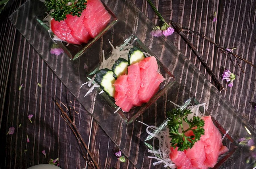Japanese cuisine pays great attention to maintaining the original flavor of food, especially the color of dishes has a high requirement, even the food containers are very particular.Looking at the exquisite Japanese cuisine like landscape painting, is it possible to feel saliva flowing? Today, let’s talk about the three characteristics of Japanese food culture!”Raw” and “fresh” culture.I don’t know if you noticed that? The Japanese prefer “raw food”. One of the major features of Japanese food culture is “raw” and “fresh”.
This point is related to the geographical location, as an island country, Japan is surrounded by sea, sea resources are very rich. Moreover, Japanese cuisine pays attention to maintaining the original flavor of food and does not advocate adding too much seasoning, so they will think that “raw food” is the most natural umami taste.
According to the concept of Japanese, fresh things are the most nutritious, the body contains the most vigorous vitality period, the best edible period of any organism is its fresh period.
The Japanese like to eat their food raw, not only raw vegetables and all kinds of plants, but also raw eggs, raw fish, raw red meat.
They think that anything that can be eaten raw must be fresh; On the other hand, only fresh things can be eaten raw.
The pursuit of exquisite culture of modeling.
The first impression of food is not the taste, but the appearance. We often ignore the appearance of food, but in fact, Japanese food pays attention to the “artistic” and “elegant sense”.
Just how sophisticated is Japanese food?
After sliced processing of sashimi orderly placement, in and around the fish body dotted with a few pieces of positive red, reverse green Perilla leaves, the color and shape of the picturesque, beautiful.
This is the art of Japanese food, from the production to the plate is too exquisite, let people have a feeling reluctant to eat.
A delicious dish, show in front of you is not only the ultimate kung fu, but also with imagination to give the beauty of the dish. The way the plates are arranged, the decorations that go with them, and even the utensils are carefully designed.
The most classic is the fugu sashimi, which is lifelike and highlights the “raw” character of the sashimi, giving the impression that the fish is still swimming in the water.
Sometimes it’s not just a mouthful, it’s a visual treat.
“Omnivorous” culture.
Simply put, eat a wide variety of food, called omnivore.
“Omnivore” can be said to be the majority of human eating habits, not unique to Japan, but the Japanese known as “the world’s first omnivore” diet structure is worth exploring.
Back in the Jomon era, there was a clear division of labor between the sexes: women gathered nuts, men hunted and fished. Later, with the introduction of rice cultivation technology to Japan, the diet structure of Japanese people changed greatly.
Since ancient times, the Japanese have always implemented the principle of omnivorous food to ensure the balance of “Yin and Yang”. Omnivorous food seems to reflect the spiritual structure, social structure and way of knowing things of Japanese people, as well as the cultural character and characteristics of Japan.
It is this concept that makes omnivorous food a feature of Japanese food culture. No matter animals, plants, fungi and so on, they can be used as table delicacies.
In recent decades, Japanese lifestyles have undergone profound changes in many ways, and none has been more dramatic than diet.
In today’s Japan, with the diversification of people’s tastes and the continuous influence of Western culture, a variety of food flooded the market, and the way of cooking is different.
